No products in the cart.
Blog
Demystifying The Average Shirt Weight For Navigating The World Of Fabrics
What’s the weight of the shirt you’re wearing? Most of us don’t often think about this seemingly trivial aspect. Still, the average shirt weight can speak volumes about its quality, durability, and suitability for different weather conditions or purposes. In this informative blog post, we delve into the fascinating world of average shirt weight, exploring its importance, how it’s calculated and what it means for you as a consumer. So, whether you’re a fashion enthusiast, a clothing retailer, or simply a curious reader, stay tuned as we unravel this overlooked but integral facet of everyday apparel.
Average Shirt Weight – How Much Does My T-Shirt Weigh?
Overview

Online shopping platforms increasingly offer details about the weight of various clothing items. This information not only aids in calculating shipping costs but also equips consumers with additional knowledge about the product, enhancing their shopping experience.
For example, understanding the average weight of your preferred T-shirts can be useful when making online purchases.
The weight of adult T-shirts typically varies from 3 to 7 ounces or more. Many factors, including the composition of the fabric, thread count, thickness, the presence of any prints or designs, and ambient humidity levels, influence this.
It is also worth noting that T-shirt weight can reflect size disparities and gender differences.
The weight of a T-shirt can provide insights into its weave, thickness, and overall quality.
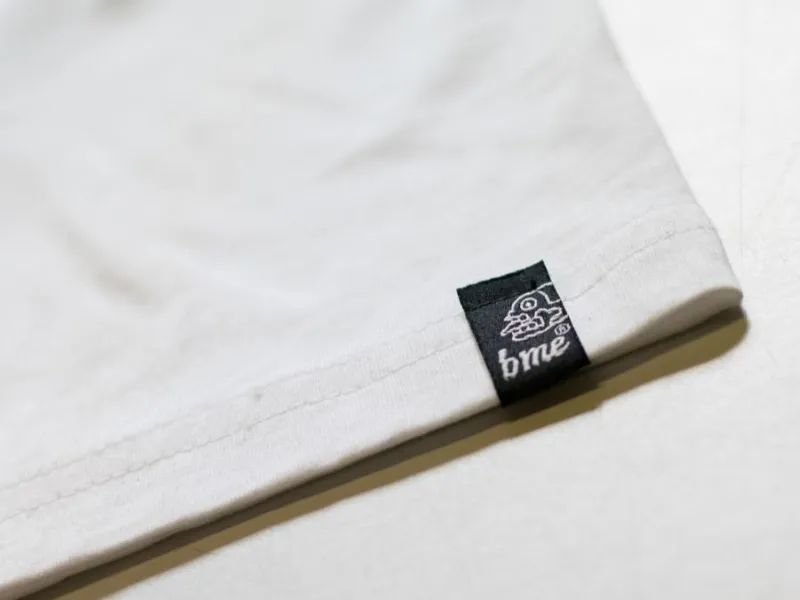
For instance, a T-shirt weighing between 3 ounces and 5 ounces is typically classified as lightweight, one between 5 ounces and 6 ounces as medium weight, and those exceeding 6 ounces are considered heavyweight.
Interestingly, medium-weight fabric might be used to construct a shirt that is classified as lightweight.
Recognising the weight of your preferred T-shirts can alleviate potential shopping confusion. For example, a small adult T-shirt weighing 6.5 ounces is significantly thicker and heavier than another weighing 3 ounces.
However, a 2XL shirt of the same 6.5 ounces weight will appear as thin and light as a 4-ounce adult small due to the additional fabric involved. Adding to the complexity is the fact that different stores report weight in different units: ounces, grams, pounds, or kilograms.
Conversation options

Understandably, converting between different weight units, such as ounces to grams or pounds to kilograms, can be a complex task that can remind one of the maths lessons from school.
For those acquainted with the American system, where 16 ounces make a pound, these conversions might be challenging if the weight is listed in metric units. Yet, these conversions are easier than they seem, and here’s how to approach them.
An ounce is equivalent to 28.35 grams. Thus, if you need to convert ounces to grams, multiply the number of ounces by 28.35 to get the weight in grams.
For instance, 3.5 ounces would convert to approximately 99.225 grams. Conversely, 1 gram equals 0.0353 ounces. Therefore, the number of grams is multiplied by 0.0353 to convert the weight from grams to ounces. As an example, 198.5 grams would be around 7.007 ounces.

In the case of larger units, 1 pound is close to 0.454 kilograms or 0.000454 grams. So, to convert the weight from pounds to kilograms, multiply the number of pounds by 0.454. Similarly, 1 kilogram is approximately 2.2 pounds or 35.27 ounces.
To convert kilograms to pounds, multiply the number of kilograms by 2.2 or 35.27 to get the weight in ounces.
Now, when it comes to the average weight of a shirt, a useful strategy is to look at the combined weight of a multipack of shirts.
For instance, if a pack of five T-shirts weighs 1 pound, it can be deduced that each T-shirt weighs about 3.2 ounces or approximately 90.72 grams. The interpretation of this weight can vary based on the size of the T-shirt.
If a T-shirt of this weight is a lady’s small, it will be considered lightweight, while a men’s XL may be considered ultra-lightweight and potentially less durable.
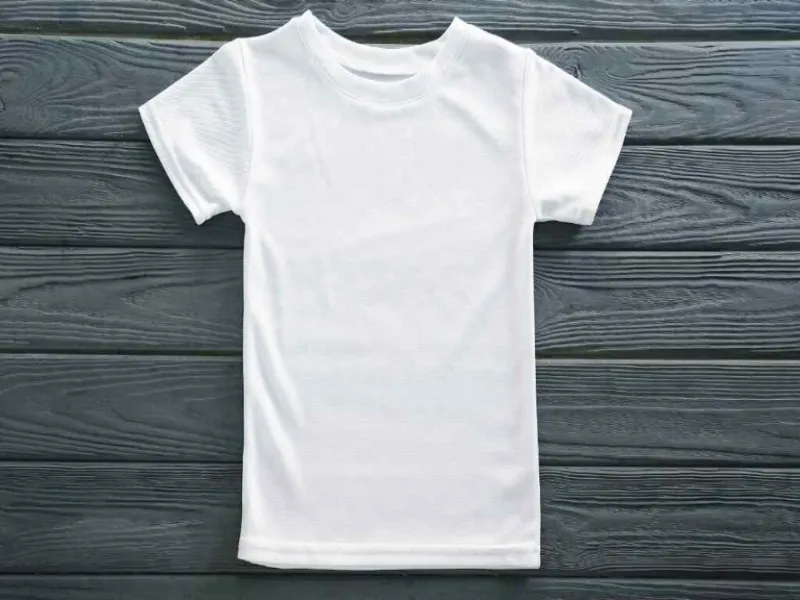
Regrettably, most manufacturers do not provide information about the weight of their shirts or the specific amount of fabric used to make each shirt. If you are into sewing, you have a general idea of the fabric needed for a T-shirt in your size and the weight of the fabric you prefer.
The weight of a T-shirt fabric is often categorised into lightweight (around 2 ounces per square yard), medium weight (around 4 ounces per square yard), and thick or heavyweight (6 ounces or more per square yard).
The width of the fabric does not affect the weight per square yard, but it does influence how many yards of fabric you may need to purchase.
The weight of the fabric per square unit combined with the quantity of fabric needed for a particular T-shirt size can give a fairly accurate estimate of the shirt’s weight.

This weight can further indicate whether the shirt is light, medium, or heavyweight. For instance, a small adult T-shirt that uses about 0.94 square yards of fabric and a 2XL T-shirt that uses around 1.5 square yards can have significantly different weights, depending on the weight of the fabric used.
A 2XL shirt made from medium-weight fabric weighs considerably more than if made from lightweight fabric, causing a notable difference in feel, warmth, and durability.
Conversation formula
The fabric calculation in a standard T-shirt, irrespective of size, can be determined through four essential measurements. These include the length from the shoulder-neck junction to the desired hemline and the chest width under the arms.
Additionally, the sleeve length from the shoulder to the cuff and double the sleeve width at its cuff are necessary measurements. The sum of the 2 parts—body and sleeves—is then doubled to account for the front and back of the shirt.

To convert to more conventional measurements, note that a square yard equals 1,296 square inches, and a square metre comprises 10,000 square centimetres.
Furthermore, an inch equals 2.54 centimetres, and 1 square inch (in²) equals 6.4516 square centimetres (cm²). The subsequent table represents the average fabric amount present in various unisex T-shirts.
Summary Table For Fabric Amount in Unisex T-Shirt Fabric
| Fabric’s Average Amount in Uni-sex T-Shirts | |||||||
| Size | Chest Width | Shirt Length | Sleeve Length | Sleeve Width x 2 | Total Square Units | Total Fabric in Yards | Total Fabric in Metres |
| X-Small | 16.5 inches (41.9cm) | 27 inches (68.6cm) | 8.63 inches (21.9cm) | 11 inches (27.9cm) | 1080.9 in² (6970.7cm²) | 0.83yds² | 0.79m² |
| Small | 18 inches (45.7cm) | 28 inches (71.1cm) | 8.9 inches (22.6cm) | 12 inches (30.5cm) | 1221.6 in² (7877.1cm²) | 0.94yds² | 0.79m² |
| Medium | 20 inches (50.8cm) | 29 inches (73.7cm) | 9.18 inches (23.3cm) | 12 inches (30.5.cm) | 1380.3 in² (8909.2cm²) | 1.07yds² | 0.89m² |
| Large | 22 inches (55.9cm) | 30 inches (76.2cm) | 9.45 inches (24cm) | 14 inches (35.6cm) | 1584.6 in² (10227.9cm²) | 1.22yds² | 1.02m² |
| XL | 24 inches (61cm) | 31 inches (78.8cm) | 9.73 inches (24.7cm) | 14 inches (35.6cm) | 1760.4 in² (11372.2cm²) | 1.36yds² | 1.14m² |
| 2XL | 26 inches (66cm) | 32 inches (81.3cm) | 10 inches (25.4cm) | 14 inches (35.6cm) | 1944 in² (12540.1cm²) | 1.5yds² | 1.25m² |
| 3XL | 28 inches (71.1cm) | 33 inches (83.8cm) | 10.4 inches (26.4cm) | 16 inches (40.6cm) | 2180.8 in² (14060cm²) | 1.68yds² | 1.41m² |
Note: Table values include average flat measurements, and they have hem and seam allowances.
Average Shirt Weight – Why Is T-Shirt Weight Important?

Fabric weight significantly influences the weight of a T-shirt, with factors such as the weave and fibre type playing crucial roles. Interestingly, a shirt composed of a cotton-polyester blend could weigh the same, less, or more than an entirely cotton one.
T-shirts made from lightweight fabric are often preferred for their softness, lightness, and flexibility. It is not uncommon for reviewers to describe them as ‘buttery-soft.’ These shirts excel in breathability, making them ideal for hot summer days.
However, they may become more transparent in humid or rainy conditions. They are easier to pack or ship due to their lightness, drying rapidly, and taking up less room. On the downside, they are more prone to wrinkles, particularly if made of cotton.
Medium-weight T-shirts present a balanced option. They can be as soft, thin, or thicker than their lightweight counterparts. They provide superior cover, maintaining opacity even when wet.
Offering protection from wind and a bit more warmth, they are less wrinkle-prone and more compressible in storage. However, their additional weight means they take longer to dry.
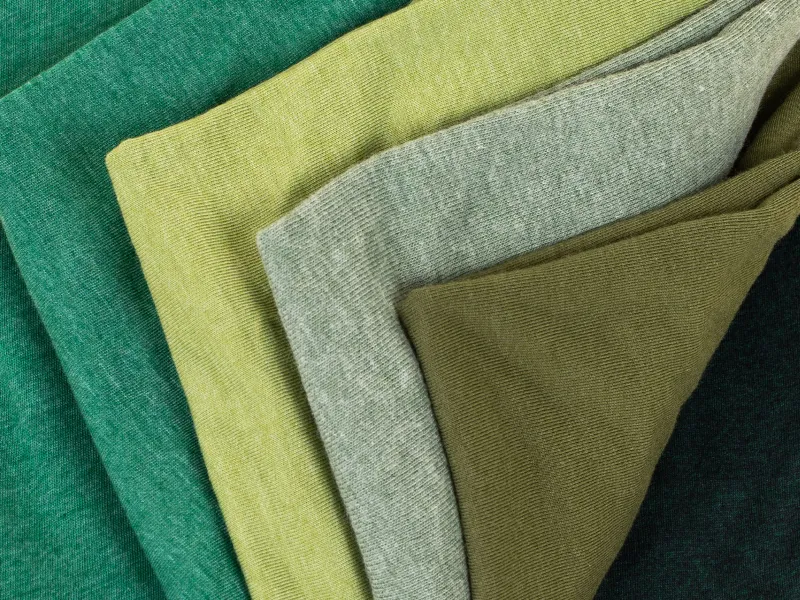
Finally, heavyweight T-shirts are a common choice for workwear or cooler climates. They might vary in texture, ranging from soft or brushed to slightly coarse.
These shirts, made from heavier, more opaque fabrics, are less prone to wrinkles but take up more space when packed and require more drying time.
Average T-Shirt Weight – A Summary Answer
Factors To Affect T-Shirt Weight
The weight classification of a T-shirt hinges on 2 factors: the weight of the fabric and the volume utilised, particularly for varied sizing.
Lightweight shirts typically fall below 5 ounces (126.75g), medium-weight shirts range between 5 and 6 ounces (170.1g), and anything above 6 ounces is classified as heavyweight.
The total weight of larger sizes typically increases due to the additional fabric required. However, if fabricated with less dense material, these shirts still fall under the lightweight or medium-weight category.
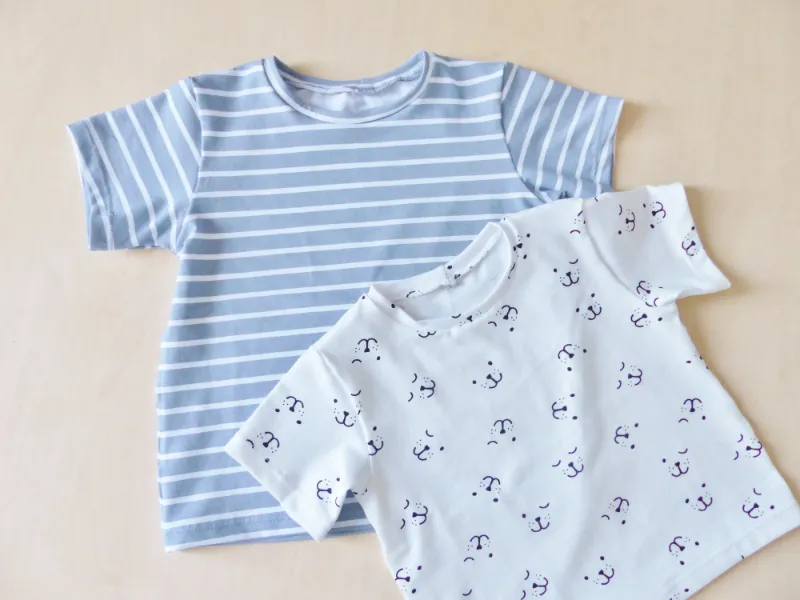
A helpful strategy to determine the weight category of a potential purchase is by comparing the fabric weight provided by various sellers against the amount of fabric used.
Comparative Table
The subsequent table provides a comparative analysis of fabric weights. It uses data from the table (Average Amount of Fabric in Uni-sex T-Shirts) and considers the fabric weight per square yard or metre, along with the weight of standard size ranges from different brands.
| Fabric and Brand Comparison of Average Uni-Sex T-Shirt Weight | ||||||
| Fabric or Brand | X-Small | Small | Medium | Large | XL | 2XL |
| 2 ounces lightweight | 1.66 ounces (47.1g) | 1.88 ounces (53.3g) | 2.14 ounces (60.7g) | 2.44 ounces (69.2g) | 2.75 ounces (77.9g) | 3.0 ounces (85.1g) |
| 4 ounces medium weight | 3.32 ounces (94.2g) | 3.76 ounces (106.6g) | 4.28 ounces (121.4g) | 4.88 ounces (138.4g) | 5.5 ounces (155.8g) | 6.0 ounces (170.2g) |
| 6 ounces heavyweight | 4.98 ounces (141.3g) | 5.64 ounces (159.9g) | 6.42 ounces (182.1g) | 7.32 ounces (208g) | 8.25 ounces (233.7g) | 9.0 ounces (255.3g) |
| American Apparel | 3.68 ounces (104.3g) | 4.16 ounces (118g) | 4.58 ounces (130g) | 4.97 ounces (141g) | 5.5 ounces (156g) | 5.78 ounces (164g) |
| Fruit of The Loom (Budget) | 3.57 ounces (101.2g) | 4.51 ounces (128g) | 4.83 ounces (137g) | 5.07 ounces (144g) | 5.64 ounces (160g) | 6.10 ounces (173g) |
| Gildan Softstyle Men’s | 3.76 ounces (106.6g) | 4.26 ounces (121g) | 4.86 ounces (138g) | 5.39 ounces (153g) | 5.67 ounces (161g) | 6.45 ounces (183g) |
| Gildan Softstyle Women’s | 3.37 ounces (95.5g) | 3.81 ounces (108g) | 4.05 ounces (115g) | 4.51 ounces (128g) | 4.97 ounces (141g) | 5.50 ounces (156g) |
Equation For Average Shirt Weight

Despite the heavy T-shirt weight classification, the 2XL shirts from a specific brand are made of medium-weight fabric. Interestingly, the same brand’s small and medium, categorised in the lightweight range, also utilise medium-weight material.
A simple equation can determine the average shirt weight: T-shirt weight divided by the amount of fabric per size roughly equals the weight used per square yard.
For instance, 6.45 ounces divided by 1.5 yds² equals 4.3 ounces – a medium-weight fabric. Similarly, 4.16ounces divided by 0.94 yds² gives 4.4ounces, again falling in the medium-weight fabric category.
Average Shirt Weight – How Do Factors Affect Weight?
Fabric Material
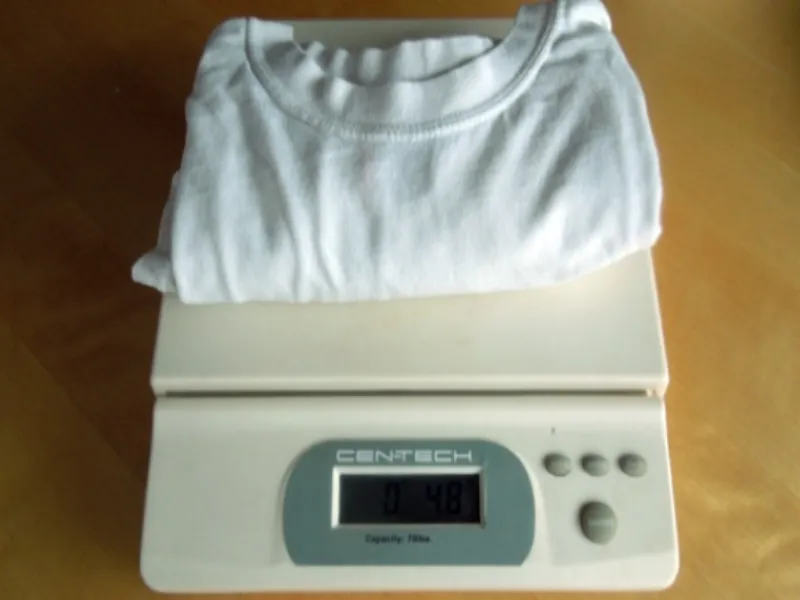
T-shirt material comprises various fibres, including natural, synthetic, or a combination. These fibres are spun into different thicknesses of yarn and then fashioned into fabric. Identifying the fabric involves measuring the thread count or determining the weight per square yard or metre.
The fabric’s weight can be categorised as light (2 ounces/yds²), medium (4 ounces/yds²), or heavyweight (6 ounces/yds²).
However, some merchants may classify fabric less than 5 ounces as light, 5 ounces to 6 ounces as medium, and any weight above 6 ounces as heavy. This varying classification can sometimes lead to misunderstanding.
The fabric weight generally depends on the yarn thickness; thicker yarn results in heavier fabric. However, the fibre’s weight also plays a role.

For instance, despite being thicker, hollow synthetic fibres are lighter than many thin natural fibres. Thus, a small, 100% cotton T-shirt could weigh the same as a T-shirt made of a 95% polyester and 5% elastane blend.
The fabric weight and quantity used in making the shirt define its base weight. However, adding elements such as pockets or images will increase the weight.
The next section will explore various T-shirt fabric blends and their weights.
| T-Shirt Fabric Weights and Blends* | ||||
| Fabric | Light Weight | Medium Weight | Heavy Weight | |
| Cotton | 3.62 ounces (122.8g) | 4.3 ounces (145.8g) | 5.3 ounces (179.7g) | 6.0 ounces (203.5g) |
| 50% cotton and 50% polyester | 3.7 ounces (125.5g) | 4.2 ounces (142.4g) | 5.5 ounces (186.5g) | 6.0 ounces (203.5g) |
| 50% polyester, 25% cotton, and 25% rayon | 3.4 ounces (115.3g) | 4.7 ounces (159.4g) | 5.64 ounces (191.3g) | 6.7 ounces (227.2g) |
| 82% polyester and 18% spandex | 3.48 ounces (118g) | 4.7 ounces (159.4g) | 5.5 ounces (186.5g) | 6.61 ounces (224.2g) |
| 95% polyester and 5% elastane | 3.74 ounces (126.8g) | 4.51 ounces (152.9g) | 5.7 ounces (193.3g) | 6.19 ounces (209.9g) |
*Weight is based on ounces per square yard (ounces/yds²) and grams per metre square (gpm).
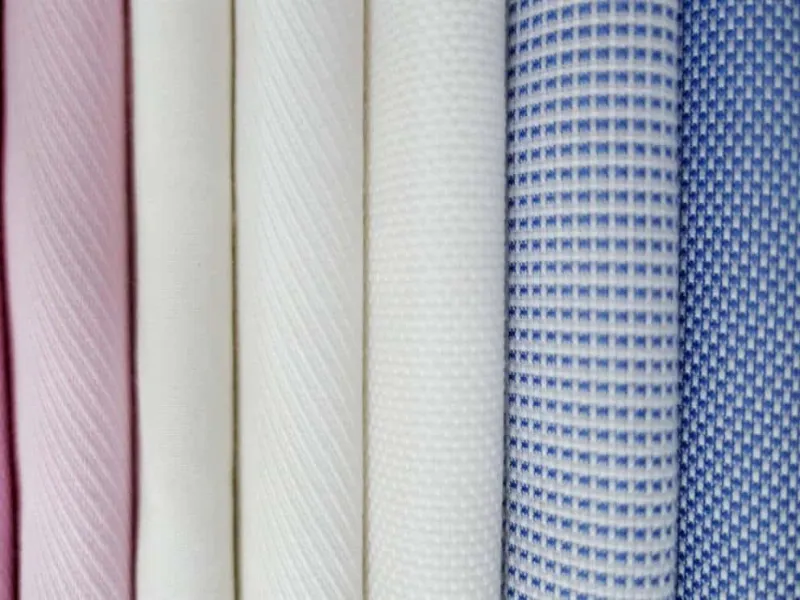
The weight of a shirt can vary depending on the blend and fabric used, with different regions having their distinct categorisation – Light, Medium, or Heavy. The weight is typically measured in ounces/yd² or g/m².
To convert from ounces/yd² to g/m², multiply the ounces/yd² value by 33.911. Conversely, to convert from g/m² to ounces/yd², divide the g/m² value by 33.911. This uniform approach to calculating average shirt weight enables easier comparison and understanding across different regions and fabric types.
- Evaluating Lightweight Fabrics
Lightweight fabrics for T-shirts boast a weight of less than 4 ounces/yd² or 135.6g/m² and can be made from entirely natural materials, synthetic fibres, or a blend of the 2.
The shirt’s weight fluctuates depending on its size, with larger sizes yielding heavier weights. These fabrics may show more wrinkles and body curves due to their lightness and may appear semi-transparent when stretched.
- Insights into Medium-Weight Fabrics

Medium-weight fabrics range between 4 ounces/yd² (135.6g/m²) and 6 ounces/yd² (203.5g/m²). Factors like thread count, yarn size, and fibre composition significantly define this weight.
T-shirts made of this fabric typically offer a comfortable balance of weight and breathability. They are flexible enough to move with the wearer while maintaining a thickness that subtly conceals body curves.
- Understanding Heavyweight Fabrics
Heavyweight T-shirt fabrics are those with a weight exceeding 6 ounces/yd² (203.5g/m²). These fabrics are markedly thicker and less flexible, thus creating a more noticeable presence for the wearer. Their lower breathability and higher warmth make them suitable for cold weather conditions.
Sizes

T-shirt weight is primarily determined by 2 factors: the size of the T-shirt and the weight of the fabric used per square yard or metre.
Naturally, smaller shirts like XS sizes, which use 0.76yd² (0.636m²) of cloth, weigh less than larger ones such as a 3XL, which utilise more than double the amount of fabric, approximately 1.55yd² (1.299m²).
The weight of the fabric itself also plays a crucial role in the overall weight of the shirt. Varying fabric weights are used across different manufacturers and factories, impacting not just the final product’s weight but also the feel and durability.
Therefore, if the same fabric weight is used, a 3XL shirt will weigh twice as much as an XS due to the increased material.
Printing Style

T-shirt weight can be influenced by the printing style employed. While adding any image will undoubtedly increase a shirt’s overall weight, the extent of this change is generally minimal. Heat transfer, screen, or digital printing techniques are commonly utilised in T-shirt design.
Among these methods, digital printing has the least impact on the shirt’s weight. This process involves:
- Directly applying the print colour to the fabric.
- Hence using minimal ink, which, in turn.
- Results in almost negligible weight addition.
This method also offers the advantage of detailed, almost photo-like prints.
On the other hand, screen printing uses more ink or paint than digital printing. This slightly increases weight due to the thicker medium’s prevalence.
However, this method allows for more vibrant colour displays. Despite being heavier than digital printing, screen printing is generally lighter than heat transfer.
Shirt Types
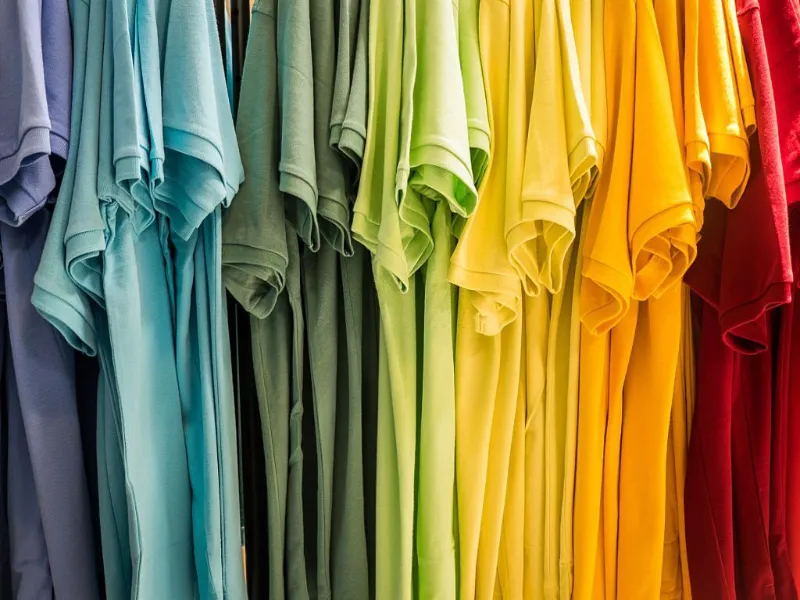
The weight of different types of shirts, such as long-sleeved tees and hoodies, is primarily determined by 3 factors: the quantity, type, and weight of the fabric utilised in their construction.
Long-sleeved t-shirts use similar material to their regular counterparts, albeit in greater quantities due to the longer sleeves, which can measure 18 to 24 inches or more, compared to the 8.6 to 10.4-inch sleeves of standard tees.
Owing to these extra inches of fabric, long-sleeved t-shirts are naturally heavier. They typically use medium to heavyweight material, ranging from 5 ounces to 6 ounces+/yd², and are often designed to be wider and longer to accommodate layering.
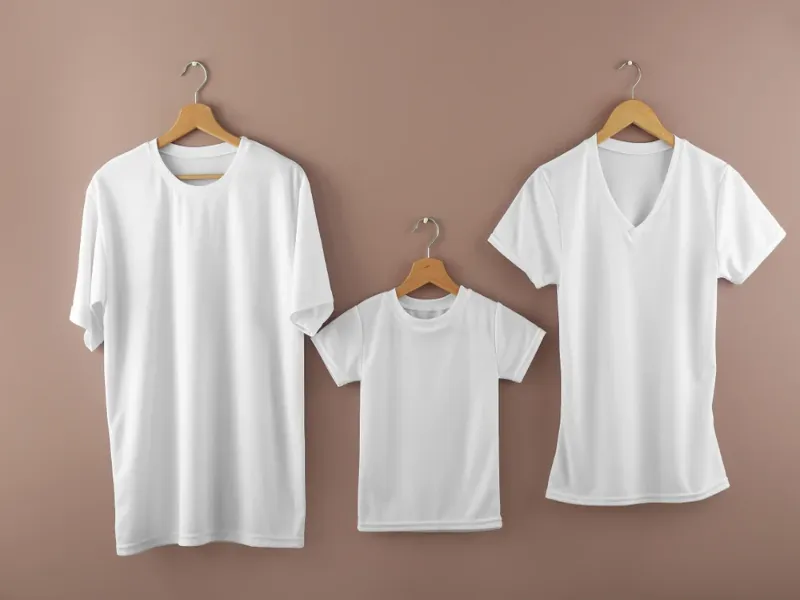
In contrast, hoodies are usually made from far thicker materials than short or long-sleeved t-shirts and are designed with extra features, such as a lace hood and pouch or pockets.
Consequently, they necessitate considerably more fabric, leading to a substantial weight increase. Often used in hoodie construction, the fleece weighs between 5.3 ounces/yd² and 14 ounces/yd².
Therefore, even a small-sized hoodie can weigh as much as 16 ounces (453.6g), with larger sizes like 2XL reaching weights of 24.7 ounces (700.3g) or even more.
Average Shirt Weight – Some Other Issues
How To Promote T-shirt Weight?
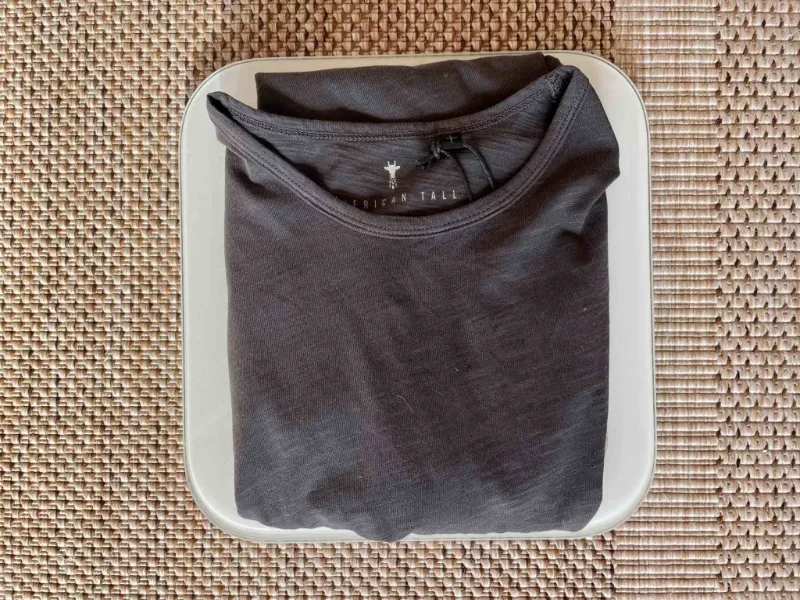
Fabric weight plays a crucial role in determining the quality and usage of a shirt. Some manufacturers use ounces per square yard or grams per square metre to quantify the fabric’s weight.
Others simplify this by categorising the material as light, medium, or heavyweight. This classification may refer to fabric composition or the product’s overall weight.
More recently, some manufacturers have started to disclose the actual weight of the shirt in ounces or grams. This method is particularly useful when estimating shipping costs or identifying the fabric weight used in production.
Which Brands Provide Information About The Fiber Composition And Cloth Weight?
The many options can be overwhelming when it comes to shopping, whether for one’s personal wardrobe or retail business. 2 notable brands in the spotlight are Bella Canvas and Next Level.
Both offer comprehensive product lines featuring many styles, sizes, and colours. They provide detailed information about the fibre composition and cloth weight of their products, all produced without sweatshops and with an emphasis on eco-friendly practices. Some of their items even incorporate recycled material.

- Bella Canvas T-Shirts
Bella Canvas offers a vibrant palette of over 50 colours in their T-shirt collection, with various neck styles and fits, from slim to relaxed.
Their sizes cater to a broad audience, with women’s sizes from XS to 2XL and men’s unisex from XS to 5XL. The company’s product diversity includes tees, tank tops, long-sleeved T-shirts, sweatshirts, hoodies, and fleece joggers.
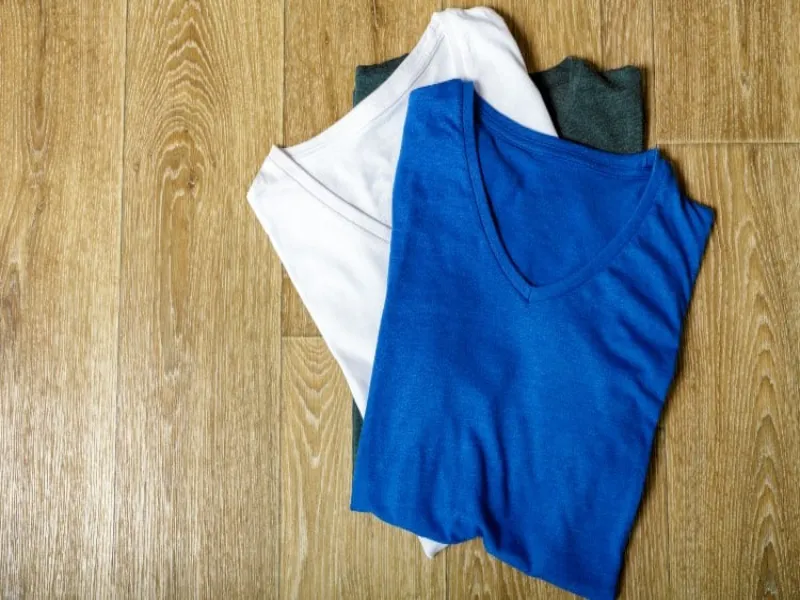
Clothing manufacture at Bella Canvas incorporates a range of fabrics and weights. Their T-shirts are made from either 3.6 ounces, 4.2 ounces, or 4.4 ounces of 100% cotton, 3.6 ounces, 4.0 ounces, or 4.2 ounces of cotton/poly blend, or 3.8 ounces tri-blend of polyester/rayon/cotton.
The specified fabric weights simplify the process of determining the weight of individual products. All shirts are suitable for both digital and screen printing.
- Next Level T-Shirts
Next Level’s T-shirt collection comes in various colours and necklines, with specifics on fabric weight and composition readily available.
Sizes range from XS to 4XL for men, XS to 3XL for women, and XS to XL for youth and children. The product offerings widened to include tank tops, long-sleeved and hooded T-shirts, sweat pants, pullovers and zip-up hoodies.

The T-shirts from Next Level are made from 4.3 ounces of 100% cotton, cotton/poly blends of varying weights (3.5 ounces, 3.9 ounces, 4.3 ounces, 5.8 ounces), or tri-blend polyester/cotton/rayon at 4.2 ounces or 4.3 ounces.
Some product fabric weight is listed as 9 ounces per linear yard, which can complicate weight calculations without knowledge of fabric width. Regardless, all products are well-suited for screen or digital print work.
How Is T-Shirt Weight For Shipping?
The weight and thickness of the fabric greatly influence shipping methods and costs. Generally, the average weight of a T-shirt is under 6 ounces, barring larger sizes.
Single or double T-shirt deliveries can be comfortably packed into sturdy soft-pack envelopes, boxboards, padded envelopes, or recycled materials. A T-shirt can be rolled compactly to fit into a shipping tube. However, bulkier items or larger orders may necessitate box packaging.
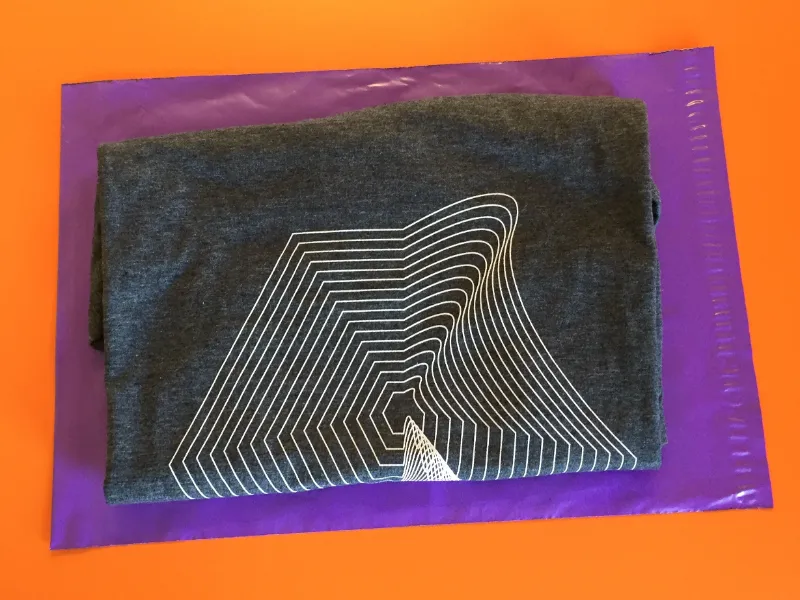
Typically, a 10-inch x 14-inch soft-pack envelope, adding around half an ounce to the overall shipping weight, is a viable choice for shipping 2 or 3 T-shirts, especially if no other packaging or paperwork is included.
However, a post office visit is mandatory for parcels exceeding 3/4 inches in thickness or intended for international delivery.
In the U.S., domestic packages weighing less than 13 ounces, no thicker than ¾ inches, and with suitable postage can be dropped in a postal box.
For packages with uncertain thickness or weight, it’s advisable to take them to a postal outlet. For many countries, the package’s size, shape, and weight could affect the shipping cost, necessitating a trip to the local Post Office.

There are other options besides postal services for package shipping. UPS and FedEx are well-known courier services capable of handling large volumes and weights.
Even though some users find them more reliable than regular postal services, they are usually more expensive. The package’s length, girth, weight, and distance determine the shipping cost.
Conclusion
In summary, the average shirt weight, generally oscillating between 3 ounces and 7 ounces, is influenced by various factors. The size of the shirt plays a substantial role, with larger sizes like 3XL having almost twice the fabric weight of an XS.
The thickness of the material also contributes significantly to the weight. While adding personalised prints to your tee doesn’t notably impact the shirt’s weight, it certainly adds a touch of uniqueness. Whether your interest lies in purchasing or shipping, understanding these nuances about the average shirt weight can prove invaluable.

